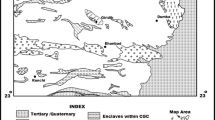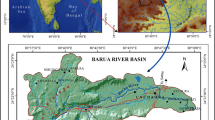Abstract
A morphometric analysis was done to determine the drainage characteristics of Lules River basin using land-sat imageries and topographical maps. This catchment was divided into seven sub-basins for the analysis: Liquimayo, Hoyada, Ciénaga, De Las Tablas, Siambón, Potrerillo and San Javier. Yungas ecoregion covers almost all the watershed. The drainage patterns of the sub-basins are dendritic and parallel. The basin includes seventh order stream and lower streams order mostly dominate the basin. The development of stream segments is affected by slope and local relief. The mean bifurcation ratio indicates that the drainage pattern is not much influenced by geological structures. The shape parameters also reveal the elongation of the basin and sub-basins.



Similar content being viewed by others

References
Brown AD (2000) Development threats to biodiversity and opportunities for conservation in the mountain ranges of the upper Bermejo river basin, NW Argentina and SW Bolivia. Ambio 29(7):445–449
Brown AD, Grau HR (1993) Selvas de montaña. Colección nuestros ecosistemas. [The mountain forests. Our ecosystem collection]. Proyecto GTZ, Salta, Argentina, 143 pp
Chow Ven T (ed) (1964) Handbook of applied hydrology. McGraw Hill Inc., New York
Fernández HR (2003) Structure of watermite taxocoenoses in two northwestern Argentinean sub-tropical sub-catchments. Syst Appl Acarol 8:55–66
Fernández HR, Molineri C (2006) Toward a sustainable experience in an intermountain valley from northwestern of Argentina. Ambio (in press)
Fernández HR, Vece MB, Manzo MV, Nieto C, Orce M (2002) Evaluación de tres índices bióticos en un río subtropical de montaña (Tucumán, Argentina) [Evaluation of three biotic indices in a subtropical mountain stream (Tucumán, Argentina)]. Limnetica 21(1–2):1–13
Frissel CA, Liss WJ, Warren CE, Hurley MD (1986) A hierarchical framework for stream habitat classification: viewing streams in a watershed context. Environ Manage 10:199–214
González O, Viruel M, Mon R, Tchilinguirian P, Barber E (2000) Hoja Geológica 2766-II San Miguel de Tucumán. 1:250,000 [Geologysheet number 2766-II San Miguel de Tucumán. 1:250,000 scale]. SEGEMAR. Boletín No. 245. Buenos Aires
Gregory KJ, Walling DE (1973) Drainage basin form and process: a geomorphological approach. Wiley, New York, 456 pp
Hadley RF, Schumm SA (1961) Sediment sources and drainage basin characteristics in upper Cheyenne River Basin. U.S. Geological Survey Water-Supply Paper 1531-B, 198 pp
Horton RE (1945) Erosional development of streams and their drainage basins. Hydrophysical approach to quantitative morphology. Geol Soc Am Bull 56(3):275–370
Hunzinger H (1997) Hydrology of montane forests in the sierra de San Javier, Tucumán, Argentina. Mt Res Dev 17(4):299–308
Lotspeich FB, Platts WS (1982) An integrated land-aquatic classification system. N Am J Fish Manage 2:138–149
Miller VC (1953) A quantitative geomorphic study of drainage basin characteristics in the Clinch Mountain area, Virginia and Tennessee. Technical report, 3, Office of Naval Research. Department of Geology, Columbia University, New York
Minetti J, Poblete AG (2003) Clasificación climática del Noroeste Argentino [Climatic classification of Northwestern of Argentina]. Laboratorio climático sudamericano. Fundación Caldenus. Universidad Nacional de Tucumán, Argentina
Schumm SA (1956) Evolution of drainage systems and slopes in badlands at Perth Amboy, New Jersey. Geol Soc Am Bull 67:597–646
Schumm SA (1963) Sinuosity of alluvial rivers on the great plains. Geol Soc Am Bull 74:1089–1100
Smith KG (1950) Standards for grading texture of erosional topography. Am J Sci 248:655–668
Sreedevi PD, Subrahmanyam K, Ahmed S (2004) The significance of morphometric analysis for obtaining groundwater potential zones in a structurally controlled terrain. Environ Geol 47:412–420
Strahler AN (1957) Quantitative analysis of watershed geomorphology. Trans Am Geophys Union 38:913–920
Strahler AN (1964) Quantitative geomorphology of drainage basin and channel networks. In: Chow VT (ed) Handbook of applied hydrology. McGraw Hill Book Co., New York, pp. 4–76
Thompson JR, Taylor MP, Fryirs KA, Brierley GJ (2001) A geomorphological framework for river characterization and habitat assessment. Aquat Conserv Mar Freshw Ecosyst 11:373–389
Verstappen H (1983) The applied geomorphology. International Institute for Aerial Survey and Earth Science (I.T.C), Enschede, The Netherlands, Amsterdam, Oxford, New York
Acknowledgements
Particular thanks to Geól. E Guido Cátedra de Geografía Física UNT, for their outstanding help with this paper, and to Fernández HR and Cisterna E for providing ideas and contributing data used. This work was supported by Agencia Nacional de Promoción Científica y Tecnológica PICT:01-12529 and the Argentine National Council of Scientific Research (CONICET).
Author information
Authors and Affiliations
Corresponding author
Rights and permissions
About this article
Cite this article
Mesa, L.M. Morphometric analysis of a subtropical Andean basin (Tucumán, Argentina). Environ Geol 50, 1235–1242 (2006). https://doi.org/10.1007/s00254-006-0297-y
Received:
Accepted:
Published:
Issue Date:
DOI: https://doi.org/10.1007/s00254-006-0297-y



